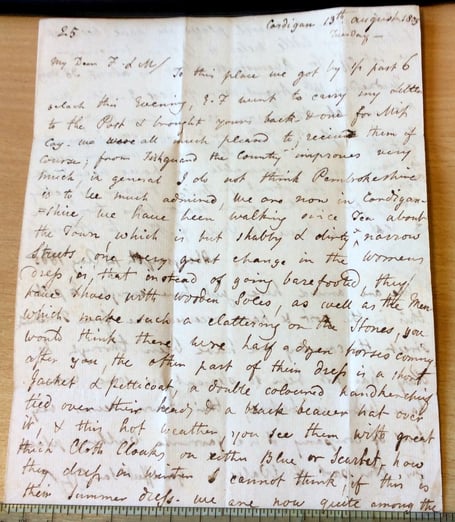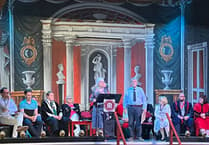‘We are now quite among the Welsh again’: A series of rare letters written in 1805 describes Cardigan as ‘dirty’ and ‘shabby’ - with people wearing ‘beaver hats’ in the hot summer - but praises Aberystwyth.
The two Georgian-era letters chart a person’s 38-mile journey through the Ceredigion countryside on 13 and 14 August 1805.
The author’s name is not known but regional historian Michael Freeman says that it seems from their less than fond descriptions of Wales and reference to bathing areas, they could have been holidaying from England writing back to parents.
The letter was found by a prominent dealer in Welsh antiques, Robert Pugh, who owns a shop in Towyside in Camarthen. He says the ‘rare’ letters were sent to a Mrs Greenwood in Clapton, Hackney, London.
The first letter on 13 August - written from Cardigan - reads: “To this place we got by half past six o’clock this evening, G.F went to carry my letters to the post and brought yours back and one for Miss Lay.
“We were all much pleased to receive them of course; from Fishguard the country improves very much, in general I do not think Pembrokeshire is to be much admired.
“We are now in Cardiganshire, we have been walking since ten about the town, which is but shabby and dirty and narrow streets.
“One very great change in the women’s dress is that instead of going barefooted, they have shoes with wooden soles, as well as the men which make such a clattering on the stones, year after year, the other part of their dress is a short jacket and petticoat, a double coloured handkerchief tied over their head and a black beaver hat over it, and this hot weather you see them with great thick cloth cloaks on either blue or scarlet.
“How they drip in winter I cannot think if this is their summer dress.
“We are now quite among the Welsh again – at several places we have been at lately very little Welsh is spoken.
“Tomorrow, we set off for Aberystwyth which is about 38 miles.”
A letter written the next day at 2.30pm reads: “We are now in Aberaeron 22 miles from Cardigan on a very rough, hill road, now and then pretty, frequently a peep at the sea, where we are now is very rural and agreeable, we have been walking down to the sea about half a mile. Dinner is getting ready for us, the horses wait here two hours to rest. We have 16 miles further to Aberystwyth.”
And just before the post office closed, they arrived in Aberystwyth, and wrote a letter which read: “We have arrived here with just enough time to put this in the post and have received one from Threadneedle Street.
“This country we have been through today has not been so pleasant as some we have been in before, this town sees very full of company, it is a favourite bathing place for this part of Wales.”
Mr Pugh said: “These kind of letters from people travelling in Wales do survive but are rather rare - particularly if they say anything interesting.
“This one covers not only the topography but the comments on dress are particularly interesting.”
Mr Freeman – the former curator of the Ceredigion Musuem in Aberystwyth town centre - told the Cambrian News: “In 1805 Aberystwyth was very much like other Welsh towns. It was often described as unattractive and dirty (there were lots of pigs in the streets); the streets were badly paved; the water supply was poor and there must have been a lot of building work going on. It improved considerably by the 1830s with many more facilities, such as the Assembly rooms, better water supply, gas lighting, drainage and pavements.
“In terms of attractions, other than the sea and the prom (which hardly existed at that time), tourists and bathers were interested in the ruins of the castle and views of the harbour; walking to Constitution hill and to St Padarn's at Llanbadarn, past Plas Crug; taking a day trip to the Devil's Bridge and Hafod; and participating in social activities in one of the two main inns (dancing, playing cards, listening to music, reading newspapers).
“Tourists rarely stayed for more than a night or two - those who came to improve their health came for several weeks but traveling here was expensive (staying here less so). The other main seaside resorts at the time were Swansea, Tenby and Barmouth.”





Comments
This article has no comments yet. Be the first to leave a comment.